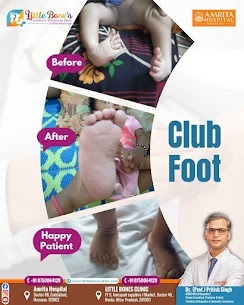What Causes Clubfoot in Newborns? Insights by Dr. Pritish Singh
Clubfoot, medically known as congenital talipes equinovarus, is one of the most common congenital deformities seen in newborns. It is a condition in which a baby’s foot is twisted out of shape or position. Although it is a manageable and treatable condition, it often leaves parents concerned and searching for clear, trustworthy answers.
For fast information direct chat with us on WhatsApp.
In this blog, Dr. Pritish Singh, a renowned pediatric orthopedic specialist at Little Bones Clinic, provides insights into what causes clubfoot in newborns, the risk factors, and how early diagnosis and intervention can make a significant difference.
Understanding Clubfoot: A Common but Correctable Condition
Clubfoot affects approximately 1 in every 1,000 live births globally. The condition may affect one or both feet, and in some cases, the feet may appear to be upside down or twisted inward. While it may sound severe, clubfoot is not painful for the infant at birth and is treatable with proper care and expert intervention.
Dr. Pritish Singh explains that understanding what causes clubfoot in newborns can help reduce anxiety for new parents and encourage timely medical attention.
What Causes Clubfoot in Newborns?
The exact cause of clubfoot is not always clear, but research and clinical experience point to several factors that could contribute to its development.
1. Genetic Influence
One of the most commonly discussed explanations for what causes clubfoot in newborns is genetics. If one or both parents had clubfoot or a sibling has been affected, the chances increase significantly. Studies show that about 25% of cases have a family history of the condition.
2. Abnormal Fetal Development
During pregnancy, if the baby’s position in the uterus restricts the movement of the legs and feet, this can lead to improper foot development. Dr. Pritish Singh notes that in some cases, abnormalities in the connective tissue or muscle structure may interfere with the correct alignment of the bones and tendons in the foot.
3. Neuromuscular Disorders
Certain neurological or muscular conditions may be linked to clubfoot. While most cases are idiopathic (of unknown origin), some are secondary to underlying conditions like spina bifida or cerebral palsy.
4. Environmental Factors
Research into what causes clubfoot in newborns also explores environmental influences during pregnancy. Smoking, certain medications, or a lack of proper nutrition during pregnancy may slightly increase the risk.
5. Intrauterine Compression
Conditions like oligohydramnios (reduced amniotic fluid) can restrict fetal movement, potentially causing mechanical deformities such as clubfoot. This lack of mobility in the womb might result in the foot growing abnormally.
Recognizing the Signs of Clubfoot
At birth, clubfoot is usually diagnosed through a physical examination. The main indicators include:
- The top of the foot being twisted downward and inward.
- The arch being more pronounced and the heel turned inward.
- Limited range of motion in the foot or ankle.
- The affected leg may appear shorter than the other.
These signs are typically evident immediately after birth. Dr. Pritish Singh emphasizes the importance of prompt consultation with a pediatric orthopedic specialist for timely diagnosis and intervention.
Is Clubfoot Preventable?
While there is no guaranteed way to prevent clubfoot, understanding what causes clubfoot in newborns helps parents be more aware, especially if there’s a family history. Maintaining a healthy pregnancy—free from harmful substances, with proper prenatal care and nutrition—can contribute to overall fetal health.
If parents already have a child born with clubfoot or a known genetic predisposition, a prenatal ultrasound during the second trimester may help detect the condition early.
Treatment and Management of Clubfoot
The good news is that clubfoot is a highly treatable condition. Most cases can be corrected without surgery if addressed early.
Dr. Pritish Singh typically recommends the Ponseti method, which involves:
- Gentle manipulation and casting of the baby’s foot, usually started shortly after birth.
- Weekly cast changes to gradually move the foot into the correct position.
- Achilles tenotomy, a minor procedure done under local anesthesia, if necessary.
- Bracing after the foot has been aligned to maintain the correction and prevent recurrence.
In some rare and resistant cases, surgical correction may be required. However, with early diagnosis and proper management, most children go on to lead active, normal lives.
Why Choose Little Bones Clinic?
When facing a condition like clubfoot, specialized care is essential. At Little Bones Clinic, Dr. Pritish Singh and his team focus exclusively on pediatric orthopedic care. From diagnosis to treatment, they offer personalized support, state-of-the-art techniques, and a compassionate approach that ensures your child’s best chance at a full recovery.
Parents across Ghaziabad and NCR trust Dr. Pritish Singh not only for his clinical expertise but for the way he communicates with families—offering clarity, comfort, and confidence.
Final Thoughts
Understanding what causes clubfoot in newborns is the first step toward addressing this common condition with confidence and care. With the right treatment approach, most children with clubfoot can walk, run, and enjoy life without limitations.
If your child has been diagnosed with clubfoot or if you’re concerned about abnormal foot positioning at birth, consulting a pediatric orthopedic expert early is crucial.
For compassionate and expert care, schedule a consultation with Dr. Pritish Singh at Little Bones Clinic—where little feet are treated with big hearts.
If your child has suffered Clubfoot or you need Treatment in Greater Noida, visit Little Bones Clinic today for the best care and a faster, smoother recovery.
Visit Us:
Little Bones Clinic, Greater Noida
https://littlebonesclinic.com





